Table of Contents
Pressure is a fundamental concept in physics and fluid mechanics that plays a crucial role in understanding the behavior of gases, liquids, and solids. It is defined as the force or thrust exerted per unit area on a surface. In simpler terms, pressure measures how much force is distributed over a given area.
Pressure is calculated using the formula:
Pressure = Thrust OR Force / Area
Where, Thrust is the magnitude of the force applied perpendicular to the surface, and Area is the perpendicular surface area on which the force is applied.
Properties of Pressure
The magnitude of Pressure: The magnitude of pressure depends on the force applied and the area over which it is distributed. Pressure is inversely proportional to the area on which the thrust is applied. It means that if the thrust is constant and the area is more, the pressure will be lesser. And if the area is less, the pressure will be more.

Units of Pressure: The SI unit of pressure is the Pascal (Pa).
Pressure can also be expressed as follows:

Hence,
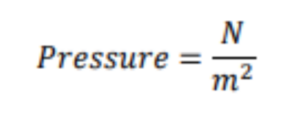
The value of 1 Pascal can be expressed as follows:

Other common units of pressure include atmospheres (atm), millimetres of mercury (mmHg), and pounds per square inch (psi).
Pressure in Fluids: In fluids (liquids and gases), pressure is transmitted equally in all directions. This is known as Pascal’s principle. In a fluid at rest, pressure increases with depth due to the weight of the fluid above it. This is expressed by the equation:
Pressure = Density × Gravity × Height
Where Density is the density of the fluid, Gravity is the acceleration due to gravity, and Height is the vertical distance from the surface.
Understanding pressure is crucial for many scientific and practical applications. It allows us to comprehend the behaviour of fluids, design effective systems, and evaluate the impact of pressure on structures and human health. Whether it’s exploring the depths of the ocean, predicting the weather, or maintaining our well-being, pressure is a concept that influences our understanding of the physical world around us.
Solved examples on Pressure Formula:
Example 1: A force of 500 Newton is applied to a circular surface with a diameter of 0.2 meters. Calculate the pressure exerted on the surface.
Solution:
Given:
Force = 500 N
Diameter = 0.2 m
Step 1: Calculate the area of the circular surface.
Area = π × (radius)2
Radius = Diameter / 2 = 0.2 m / 2 = 0.1 m
Area = π × (0.1 m)2 = 0.0314 m²
Step 2: Calculate the pressure.
Pressure = Force / Area
Pressure = 500 N / 0.0314 m² ≈ 15,923.57 Pa
Therefore, the pressure exerted on the surface is approximately 15,923.57 Pascal (Pa).
Example 2: A block of wood is kept on a table. The mass of the wooden block is 500 grams and its dimensions are 5 cm × 3cm × 2 cm. Let us find the thrust and pressure exerted by it on the table if it is made to lie on it with its sides of dimensions (A) 5 cm × 3 cm and (B) 3 cm × 2 cm.
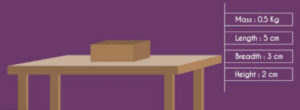
Solution:
Let us find the thrust and pressure exerted by the block on the table in each of the cases.
Thrust calculation:
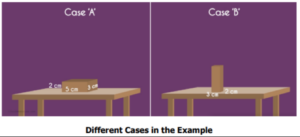
The weight of the wooden block applies a thrust on the table. Since the weight of the box is the same in both the cases the value of thrust will also be the same. The thrust can be calculated as follows,
𝑇ℎ𝑟𝑢𝑠𝑡 = 𝐹 = 𝑚 × 𝑔
Where, ‘m’ is the mass of the block and ‘g’ is the acceleration due to gravity. The mass ‘m’ is 500 grams, which is equivalent to 0.5 kilograms and ‘g’ is 9.8 m/s2.
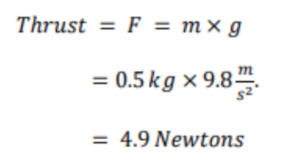
Pressure calculation:
We can calculate the pressure in both the cars using the pressure formula,
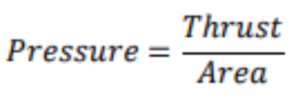
In case A, the area of the box in contact with the table is,
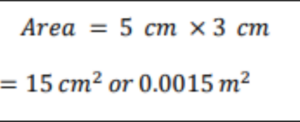
We can calculate the pressure as follows:

We can also calculate the pressure in case B as follows:
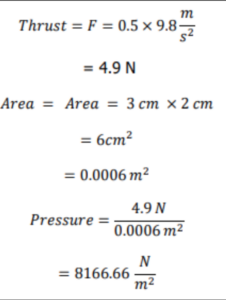
Hence, the pressure in case B is much more than that in case A. This is because the area of contact is lesser in case B.
Frequently Asked Questions on Pressure Formula
What is pressure?
Pressure is the force applied per unit area on a surface. It is a measure of how much force is distributed over a given area.
What are the SI units of pressure?
The SI unit of pressure is the Pascal (Pa), which is equal to one Newton per square meter (N/m²). Other common units include atmospheres (atm), millimetres of mercury (mmHg), and pounds per square inch (psi).
How is pressure calculated?
Pressure is calculated by dividing the force applied on a surface by the area over which the force is distributed. The formula for pressure is: Pressure = Force / Area.
What is the difference between gauge pressure and absolute pressure?
Gauge pressure is the pressure measured relative to atmospheric pressure, while absolute pressure is the total pressure, including atmospheric pressure. Absolute pressure is measured with respect to a perfect vacuum.
How does pressure change with depth in a fluid?
In a fluid at rest, pressure increases with depth. This is due to the weight of the fluid above, causing an increase in the force exerted on a given area at greater depths.



